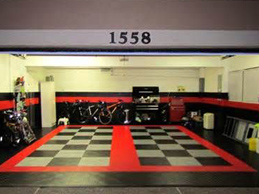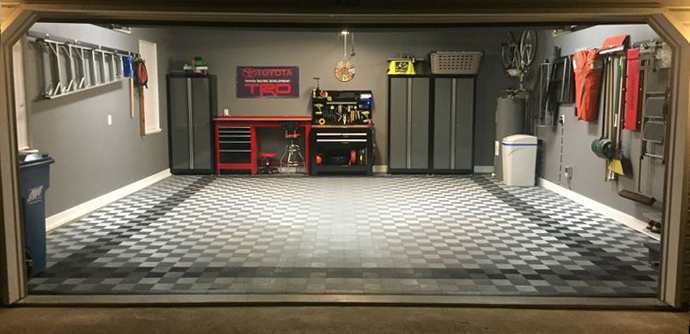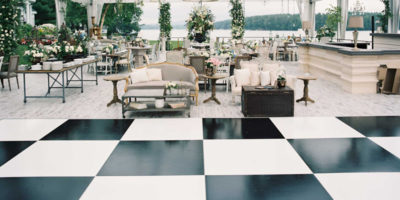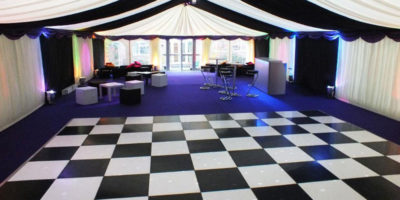Modular Garage Flooring Enhances Your Garage Space
If you are looking for a way to protect your garage floor without messy adhesives or toxic fumes during installation, than modular garage flooring is your answer.
Modular garage floor tiles are easy to install and easy to remove. They can even go with you if you move. Different patterns are available as well as many colors so you can design a look that is right for you. Modular garage floor tiles are skid and slip resistant.
In addition to being portable and easy to install, modular garage floor tiles protect your floor surface and are easy to maintain. They are not affected by petroleum products such as grease, oil or gasoline and clean easily with a household cleaner and water.
The interlocking system of modular garage floor tiles will not separate when the wheels of the car are turned and they have great roll over strength. The tiles can easily support heavy vehicles such as SUV’s and trucks.
Installation of modular garage floor tiles not only adds value to the square footage of your home, but also protects you and the investment you have made in your concrete floor.
Garage Floor Interlocking Tile: Pros And Cons
Garage floor interlocking tiles are one of the easiest ways of protecting your garage floor. Unlike floor coating,  tiles require very little surface preparation and can be installed over cracked, chipped or stained concrete. Garage floor tiles are available in two materials: plastic and vinyl composition tiles (VCT). The plastic tiles are simple to assemble with a hook or another type of built in retention feature. VCT are vinyl tiles that have to be glued to the floor and give a slicker look than plastic tiles.
tiles require very little surface preparation and can be installed over cracked, chipped or stained concrete. Garage floor tiles are available in two materials: plastic and vinyl composition tiles (VCT). The plastic tiles are simple to assemble with a hook or another type of built in retention feature. VCT are vinyl tiles that have to be glued to the floor and give a slicker look than plastic tiles.
Here are some pros and cons to be considered before selecting garage floor tiles.
Plastic Tile Pros and Cons:
- Plastic interlocking tiles are easy and quick to install.
- They are portable, so you can take them with you when you change residence.
- You can create decorative patterns with different colors.
- No adhesive is required.
- Plastic provides insulation from a cold concrete floor.
- Plastic tiles make a hollow sound when walking.
VCT Pros and Cons:
- Vinyl tiles provide a attractive look and a smooth finish
- Fluids like water, oil are likely to seep down under the tiles, as the seams are not watertight.
- VCT can be slippery when wet or greasy.
- VCT requires adhesives and depends on proper conditions for curing.
- It would be difficult to remove VCT when changing residence.
- VCT requires proper planning for layout and shape.
- There are several solutions to improving your garage, and two of the best ideas for this are reflooring and organizing. If you need to (or can afford to) do both it makes more sense to first work on the flooring, as there’s no sense in organizing your garage only to have to move everything again to refloor it.
- The biggest benefit to reflooring is protection for your subfloor. Daily wear and tear on most garage floors can be tough, so your options will depend on how you plan to use your garage. However, garage flooring doesn’t have to be expensive in order to be good. You can actually cut costs without sacrificing quality by looking into some of these options.
Rubber
- This is the least expensive method, but it has limited use. Rubber works well if you plan on your garage functioning as a kid’s playroom, a family room, a workout room with a home gym, or primarily as a storage facility.
Pros
- Rubber provides good insulation and a sound buffer when there’s going to be a lot of movement through the garage. It also offers additional safety against minor injuries from falling.
Cons
- Petroleum products like oils and grease and heat can damage rubber flooring, so if you live in a hot climate, don’t leave the garage door open for long periods of time. Also watch out for hot car tires; you won’t be happy with melted rubber in your garage.
Roll-out PVC Flooring
- Slightly more expensive than rubber, PVC—also known as mat flooring—makes a notable difference in a garage. It’s easier to install than tougher materials like epoxy. It doesn’t require adhesive, and cleaning is a cinch since you can pick up the mats and hose them off if needed.
Pros
- Mats come in a variety of colors for any kind of theme you might be following. Patterned or ribbed designs help with traction, and as we mentioned before, it is less expensive and easier to install than epoxy.
Cons
- There aren’t many downsides to roll-out PVC, but don’t expect it to look like a designer job. And, while installation is relatively easy (all you need is a utility/carpet knife), you’ll want to take care to join your edges with an overlapping technique to avoid creating seams.
Tile PVC Flooring
- Tile provides more of a professional look that the roll-out type. Like its mat counterpart, it’s fairly easy to install as no adhesive is necessary. It’s a bit thicker than the mats, so you’ll need a cutting tool that’s stronger than a utility knife when installing. You may want to opt for the interlocking tiles as they’ll create a seamless look.
Pros
- This type of PVC also comes in a variety of colors and patterns and is easy to install. This flooring will create a nicer look than using PVC mats.
Cons
- The thicker mat surface is easier to dent and mar. However, there are self-correcting tiles that will spring back into shape after a couple of days. While installation is still easy, it will take longer to install than the roll-out type.
Epoxy
- This is the most expensive of the aforementioned flooring options and it is the most difficult to install. If you aren’t experienced at this, start looking for someone who is, or find a professional. Also, don’t scrimp on the quality of the epoxy product; there are some sub-standard products out there that will cause you grief in the long run.
Pros
- Epoxy is very durable and with proper installation, it will look great and offer lasting protection to your garage subfloor.
Cons
- It is difficult and time consuming to install for any DIYer, so you will probably need to seek out professional help. Obviously this also piles additional costs on top of the more expensive material.
Other Flooring Alternatives
- There are several additional types of flooring styles made by different manufacturers that don’t fall into these larger categories. If you’ll be working with tiles, the interlocking ones are best, for both aesthetic reasons and because they hold up well to turning tires. Costs will vary on the usual factors—style, quality, the amount of product needed, shipping fees, etc.
Designs
- Just because it’s a garage floor doesn’t mean it has to be boring. Choose among a wide selection of intricate designs available including diamond plate, ribbed, coin, etc.
Wood Veneers
- If you are utilizing your garage as a second family room or play room for the toddlers, you might even consider veneers. Yes, faux wood does have a home in the garage.
Paints
- If you’re floor is dingy, but in otherwise good condition, you might be able to spruce things up a bit with a splash of color and shine with concrete paint.
Area Mats
- A fall-back option to doing the entire floor is to use garage floor mats in a select area. They come in different sizes and textures and are easily transportable. They’re also good for preventing floor stains, grease spots, and can do double duty work in basements. Containment mats will usually have raised edges thereby allowing them to hold liquids such as oil, grease, water, coolant, etc. These can even be great to use on an already-refloored garage.
- In the end, reflooring your garage will not only make it more enjoyable and easier to maintain, but it will add more utility to this often under-appreciated space that is part of your home. Additionally, a garage that looks well-kept just might improve your home’s resale value
- 3 Best Garage Floor Coating Systems
- More and more people want to improve the looks of their garage by using a garage floor coating system. There are more than a few types to choose from, but this article will look at some of the more popular ones.
1. Epoxy Garage Floor Treatment
- Epoxy garage floor treatments provide a finished look to your garage as well as giving resistance to oil stains. Epoxy floors allow water to bead so spills can be wiped up much like they are on your kitchen counters. Adding color to the epoxy paint will help in hiding imperfections in the floor, and anti-skid additives provide better traction when driving on it with wet tires.
- Epoxy treatments require a lot of prep work. Any concrete stains or sealers will need to be stripped off before you can apply the epoxy paint. If the prep work is not done properly, the epoxy treatment will not adhere correctly and will flake off and chip.
- The epoxy must be applied on a very dry day with no chance of rain or dampness and with temperatures between 50 and 80 degrees Fahrenheit. Epoxy painting the garage floor is a time-consuming process as well. Each step in the preparation process can take 12 to 24 hours to complete before the next step can begin.
2. Garage Floor Tiles
- Garage floor tiles are a much easier option than the epoxy paint. The tiles require no floor preparation or adhesives and no special skills are needed.
- Garage floor tiles also come in a variety of colors and styles. These tiles can last for up to 30 years, and some solid tiles can hold as much as 60,000 pounds. They install with just a rubber mallet and can be cut with any power saw, and they lock together to form a watertight seal to guard against damage to the garage subfloor.
3. Rollout Garage Mats
- These rollout garage mats are extremely easy to install; they literally just roll out onto your garage floor. They come in a variety of sizes and can be cut for a custom wall-to-wall fit.
- They also come in many colors and patterns to further customize the look of your garage and are manufactured from polyvinyl material. Some garage floor mats can last as long as 10 years before replacement is necessary.
- Each garage floor coating system has its merits and faults. The epoxy paint system is by far the most popular and also the least expensive, but it is also the most time-consuming and very unforgiving if the garage floor surface is not prepared properly. Also, not every garage floor is compatible with the epoxy paint.
- The garage tiles and garage mats are similar in function and style; however, the garage tile system is the most durable of the three. These two systems require no special floor preparation other than a thorough sweeping to remove any debris that would prevent a smooth installation.
- As with all home improvement projects, this choice is up to each homeowner and their personal taste and preference.












Recent Comments